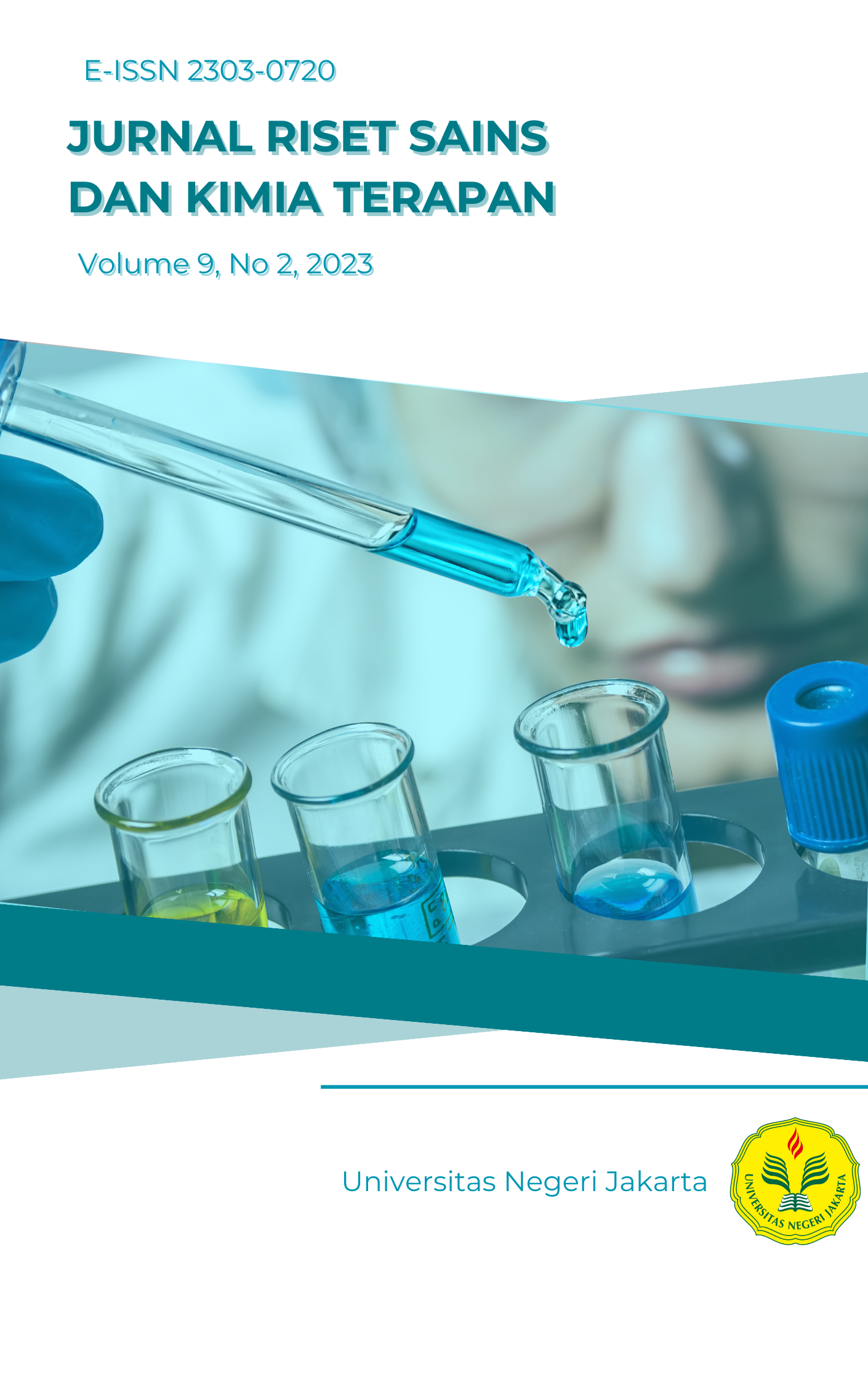Deteksi Cepat Foodborne Pathogen Bakteri Cronobacter Sakazakii pada Susu Formula dengan Metode Real -Time Polymerase Chain Reaction
DOI:
https://doi.org/10.21009/JRSKT.092.03Keywords:
Foodborne pathogen, Cronobacter sakazakii, real-time PCRAbstract
Abstrak
Keracunan pangan merupakan masalah yang sangat serius dan berpengaruh besar dalam kehidupan manusia. Keracunan pangan dapat terjadi ketika mikroorganisme patogen atau zat kimia beracun mengkontaminasi pangan dan dikonsumsi oleh makhluk hidup. Mikroorganisme patogen yang dapat mengkontaminasi pangan atau foodborne pathogen salah satunya adalah bakteri Cronobacter sakazakii yang merupakan bakteri gram negatif. Bahaya yang ditimbulkan oleh adanya kontaminasi C. sakazakii menjadi masalah dan tindakan pencegahannya masih sangat minim karena kurang adanya sarana dan prasarana yang memadai. Salah satu pengembangan metode yang dikembangkan adalah real-time PCR. Pada penelitian ini, dilakukan deteksi Cronobacter sakazakii pada susu formula menggunakan real-time PCR yang dikultur pada media cair Buffered Peptone Water (BPW). Cronobacter sakazakii diektraksi menggunakan kit Viogene® MiniPlus Plasmid DNA Extraction System. Konsentrasi dan kemurnian isolat diperiksa pada Nanovue spectrophotometer dengan rasio A260/A280 yang menghasilkan konsentrasi sebesar 282 ng/µL dan 88 ng/µL serta kemurnian sebesar 2.153 dan 2.178. Hasil pendeteksian menggunakan rt-PCR direpresentasikan dalam bentuk kurva amplifikasi dan melting curve. Sampel dinyatakan positif terkontaminasi Cronobacter sakazakii pada nilai Ct 22.033 dan Ct 16.732. Melting curve yang dihasilkan memiliki nilai 81.67℃ dan 80.95℃.
Kata kunci: Foodborne pathogen, Cronobacter sakazakii, real-time PCR
Abstract
Food poisoning is a very serious problem and has a great influence on human life. Food poisoning can occur when pathogenic microorganisms or toxic chemicals contaminate food and are consumed by living beings. One of the pathogenic microorganisms that can contaminate food or foodborne pathogens is the Cronobacter sakazakii bacteria which is a gram-negative bacterium. The danger posed by the presence of C. sakazakii contamination is a problem and prevention measures are still very minimal due to the lack of adequate facilities and infrastructure. In this study, detection of Cronobacter sakazakii in infant formula was carried out using real-time PCR cultured on Buffered Peptone Water (BPW) liquid media. Cronobacter sakazakii was extracted using Viogene® MiniPlus Plasmid DNA Extraction System kit. The concentration and purity of the isolate were checked on a Nanovue spectrophotometer with an A260/A280 ratio resulting in concentrations of 282 ng/µL and 88 ng/µL and purities of 2.153 and 2.178. These detection results are represented in the form of an amplification curve and melting curve. Samples tested positive for Cronobacter sakazakii contamination at Ct 22,033 and Ct 16,732. The melting curve of Cronobacter sakazakii in the samples had values of 81.67℃ and 80.95℃.
Keywords: Foodborne pathogen, Cronobacter sakazakii, real-time PCR
References
Anthis, NJ & Clore, GM 2013, ‘ Sequence‐specific determination of protein and peptide concentrations by absorbance at 205 nm’. Protein Science, 22(6), 851-858, https://doi.org/10.1002/pro.2253.
Bai, Y, Yu, H, Guo, D, Fei, S, & Shi, C 2019, ‘Survival and environmental stress resistance of Cronobacter sakazakii exposed to vacuum or air packaging and stored at different temperatures’. Frontiers in Microbiology, 10, 303, https://doi.org/10.3389/fmicb.2019.00303.
BPOM 2021, ’Laporan Tahunan Badan POM Tahun 2020’.131-132.
Braun, CJP & Hammer, P 2011, ‘Reservoir and routes of transmission of Enterobacter sakazakii (Cronobacter spp.) in a milk powder producing plant’. Journal of dairy science, 94(8), 3801-3810, https://doi.org/10.3168/jds.2011-4318.
Breeuwer, P, Lardeau, A, Peterz, M & Joosten, H 2023, ‘Desiccation and heat tolerance of Enterobacter’. Journal of Applied Microbiology, 95(5), 967–973, https://doi.org/10.1046/j.1365-2672.2003.02067.x.
Budiarso, TY & Winarni, HCS 2016, ‘Isolasi dan Identifikasi Enterobacter sakazakii’. Jurnal Sain Veteran, 34(2), https://doi.org/10.22146/jsv.27565.
Campbell, MS & Wright, AC 2003, ‘Real-time PCR analysis of Vibrio vulnificus from oysters’. Applied and environmental microbiology, 69(12), 7137-7144, https://doi.org/10.1128/AEM.69.12.7137-7144.2003.
CDC, "Cronobacter: Expanded Information’.
Chen, W, Ai, L, Yang, J, Ren, J, Li, Y & Guo, B, 2013, ‘Development of a PCR assay for rapid detection of Cronobacter spp. from food’. Canadian Journal of Microbiology, 59(10), pp. 656-661, https://doi.org/10.1139/cjm-2013-0243.
Dorak, M 2006, ‘Real-time PCR’, 1 ed., London, https://doi.org/10.4324/9780203967317.
Fakruddin, M, Rahaman, M, Ahmed, MM & Hoque, MM 2014, ‘Stress tolerant virulent strains of Cronobacter sakazakii from food’. Biological research, 47, 1-12, https://doi.org/10.1186/0717-6287-47-63.
Henry, M & Fouladkhah, A 2019, ‘Outbreak history, biofilm formation, and preventive measures for control of cronobacter sakazakii in infant formula and infant care settings’. Microorganisms, 7(3), 77, https://doi.org/10.3390/microorganisms7030077.
Hunter, CJ & Bean JF 2013, ‘Cronobacter: an emerging opportunistic pathogen associated with neonatal meningitis, sepsis and necrotizing enterocolitis’. Journal of perinatology: official journal of the California Perinatal Association, 33, 581–585, https://doi.org/10.1038/jp.2013.26.
Kabense, R, Ginting, EL, Wullur, S, Kawung, NJ, Losung, F & Tombokan, JL 2019, ‘Penapisan Bakteri Proteolitik yang Bersimbiosis dengan Alga Gracillaria sp’. Jurnal Ilmiah Platax, 7(2), 413-418, http://ejournal.unsrat.ac.id/index.php/platax413.
Kralik, P & Ricchi, M 2017, ‘A basic guide to real time PCR in microbial diagnostics: definitions, parameters, and everything’. Frontiers in microbiology, 8, 239909, https://doi.org/10.3389/fmicb.2017.00108.
Lee, H & Yoon Y 2021, ‘Etiological Agents Implicated in Foodborne Illness World Wide’. Food science of animal resources, 40(1), 1-7, https://doi.org/10.5851/kosfa.2020.e75.
Lobert, S, Hiser, L & Correia, JJ 2010, ‘Expression profiling of tubulin isotypes and microtubule-interacting proteins using real-time polymerase chain reaction’. Methods in cell biology, 95, 47-58, https://doi.org/10.1016/S0091-679X(10)95004-8.
Lucena-Aguilar, G, Sánchez-López, AM, Barberán-Aceituno, C, Carrillo-Avila, JA, López-Guerrero, JA & Aguilar-Quesada, R 2016, ‘DNA source selection for downstream applications based on DNA quality indicators analysis’. Biopreservation and biobanking, 14(4), 264-270, https://doi.org/10.1089/bio.2015.0064.
Luo, G, Zhang, J, Zhang, S, Hu, B, Hu, L & Huang, Z 2021, ‘High-quality RT-PCR with chemically modified RNA controls’. Talanta, 224, 121850, https://doi.org/10.1016/j.talanta.2020.121850.
Moldovan, E & Moldovan, V 2020, ‘Controls in real-time polymerase chain reaction based techniques’. Acta Marisiensis-Seria Medica, 66(3), 79-82, 10.2478/amma-2020-0025.
Nurjayadi, M, Pertiwi, YP, Islami, N, Azizah, N, Efrianti, UR, Saamia, V & El-Enshasye, HA 2019, ‘Detection of the Salmonella typhi bacteria in contaminated egg using real-time PCR to develop rapid detection of food poisoning bacteria’. Biocatalysis and agricultural biotechnology, 20, 101214, https://doi.org/10.1016/j.bcab.2019.101214.
Osaili, T & Forsythe, S 2009, ‘Desiccation resistance and persistence of Cronobacter species in infant’. Int J Food Microbiol International, 136(2), pp. 214-220, 31 December 2009. https://doi.org/10.1016/j.ijfoodmicro.2009.08.006.
Sasmito, DEK, Kurniawan, R dan Muhimmah, I 2014, ‘Karakteristik primer pada Polymerase Chain Reaction (PCR) untuk sekuensing DNA: mini review’. In Seminar Nasional Informatika Medis (SNIMed) 93-102.
Wangler, MF & Bellen, HJ 2017, ‘In vivo animal modeling: Drosophila. In Basic Science Methods for Clinical Researchers’. Academic Press, 211-234, https://doi.org/10.1016/B978-0-12-803077-6.00012-6.
W. H. O. [WHO] 2015, ‘WHO estimates of the global burden of foodborne diseases’. 2-73.
Widayat, W, Agustini, TW, Suzery, M, Al-Baarri, ANM, Putri, SR & Kurdianto, K 2019, ‘Real time-polymerase chain reaction (RT-PCR) sebagai alat deteksi DNA babi dalam beberapa produk non-pangan’. Indonesia Journal of Halal, 2(1), 26-33, https://doi.org/10.14710/halal.v2i1.5361v.
Yeni, T & Hamdi 2023, ‘Analisa Mikrobiologi Menggunakan Nacl sebagai Bahan Alternatif Buffer Peptone Water pada Produk Desiccated Coconut di Pt. Unicoco Industries Indonesia," Jurnal Agroindustri Pangan, 2(1), 88-104.







